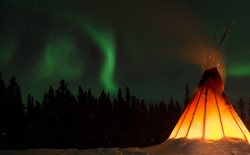
Canadians take immense and justifiable pride in the diversity of their bi-lingual melting pot population. While no visit to Canada is complete without an exploration of the country’s rich French and British cultural roots, of equal interest is the enduring legacy of the First Nations or
Les Premières Nations. This moniker refers to the aboriginal peoples who dwelt south of the Arctic in Canada, and is considered by Canadians to be more politically correct than the American misnomer “Indians.”
In a country as large and climactically diverse as Canada, it should come as no surprise that the First Nations are as varied as the peoples of Asia and Africa. Canada recognizes 634 distinct peoples, many of whom can trace their history back to 1000 - 500 BC, largely through oral traditions of storytelling. For the sake of clarity tribes have been grouped into six distinct geographic peoples, who share commonalities of lifestyle, husbandry, and diet. While vastly different, the overwhelming majority of First Nations share a nature-based belief system, giving thanks to a Creator, synonymous with the earth for the bounty, which sustains them.
Woodland First Nations: this loose confederation of independent tribes lived a semi-nomadic existence as hunters and trappers in the verdant forests of eastern Canada. They traveled by water in birch bark canoes, following the migration of their quarry. Their social hierarchy valued the strongest and most skilled hunter of the tribe.
Iroquoian First Nations were farmers, living in the fertile southern areas of Canada where they lived a more sedintary life than other First Nations, growing corn, maize, beans and squash. This more settled, easier agricultural lifestyle gave rise to a more complex governmental structure to their society based on democratic principles.
The Plains First Nations roamed the grasslands of the prairies hunting buffalo. Nomadic and fiercely independent, they lived in tipis made from buffalo hide stretched on highly-sought-after long pine poles. Though each individual tribe kept largely to itself, they came together each summer for hunting and festivals.
The Plateau First Nations made their homes in the semi-deserts of the south and the high mountains of the north. Here they built insulated houses over pits dug into the earth, always constructed near rivers, so that fish, their primary source of sustenance, would be available.
The Pacific Coast First Nations were the most sedentary of the lot, using the abundant cedar timber of their region to construct vast dwellings, that reflected their skills at carpentry. Blessed with abundant seafood and river fish, the Pacific Coast First Nations developed a complex class structure, which recognized an aristocracy and a lower class.
The Mackenzie and Yukon River First Nations endured the harsh winters and scarcity of game of their region, covering vast tracks of territory in search of meat, living in portable homes and traveling in birch bark canoes held together with spruce gum.
Join Alexander + Roberts in learning more about Canada’s First Nations on an epic voyage through Canada’s stunning northwest:
Canada by Land, Water & Rail.